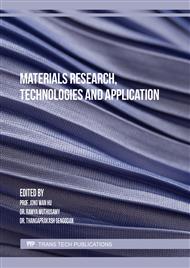[1]
K.J. Jenkins, Mix Design Considerations for Cold and Half-Warm Bituminous Mixes with Emphasis on Foamed Bitumen. Ph.D. Thesis, Department of Civil Engineering, Faculty of Engineering, University of Stellenbosch, Stellebosch, South Africa, (2000).
Google Scholar
[2]
M.B. Немчинов, A.C. Холин, A.B. Корочкин. Дорожные одежды с асфальтобетонным покрытием. Физика работы. Методология проектирования и расчёта. Прочность и долговечность. (Asphalt road pavements. The physics of their work. Design and calculation methodology. Strength and durability). Association of civil engineering universities, Moscow, (2019).
Google Scholar
[3]
B. W. Hailesilassie, M. Hugener, M. N. Partl; Influence of foaming water content on foam asphalt mixtures. Constr. Build. Mater. 85 (2015) 65-77.
DOI: 10.1016/j.conbuildmat.2015.03.071
Google Scholar
[4]
X. Yu, Y. Wang, T. Luo, Impacts of water content on rheological properties and performance-related behaviours of foamed war-mix asphalt. Constr. Build. Mater. 48 (2013) 203–209.
DOI: 10.1016/j.conbuildmat.2013.06.018
Google Scholar
[5]
M.M Iwański, A. Chomicz-Kowalska, K. Maciejewski, Impact of Additives on the Foamability of a Road Paving Bitumen. IOP Conference Series: Materials Science and Engineering, 603 (2019) 1-10.
DOI: 10.1088/1757-899x/603/4/042040
Google Scholar
[6]
M.R.D. Hugo Silva, R.M. Joel, J. Oliveira, J. Peralta, S. E. Zooro, S.E. Optimization of warm mix asphalt using different blends of binders and synthetic paraffin wax contents. Constr. Build. Mater. 24 (2010) 1621–1631.
DOI: 10.1016/j.conbuildmat.2010.02.030
Google Scholar
[7]
M. M. Iwański, A. Chomicz-Kowalska, K. Maciejewski: Effect of Surface Active Agent (SAA) on 50/70 Bitumen Foaming Characteristics. Materials. 12 (2019) 1-20.
DOI: 10.3390/ma12213514
Google Scholar
[8]
Sanchez-Alonso, E.; Vega-Zamanillo, A.; Castro-Fresno, D.; Del Rio-Prat, M. Evaluation of compactability and mechanical properties of bituminous mixes with warm additives. Constr. Build. Mater. 25 (2011) 2304–2311.
DOI: 10.1016/j.conbuildmat.2010.11.024
Google Scholar
[9]
A. Chomicz-Kowalska, K. Maciejewski, M. M. Iwański: Study of the Simultaneous Utilization of Mechanical Water Foaming and Zeolites and Their Effects on the Properties of Warm Mix Asphalt Concrete. Materials. 13 (2020) 1-22.
DOI: 10.3390/ma13020357
Google Scholar
[10]
Leng, Z.; Gamez, A.; Al-Qadi, I.L. Mechanical property characterization of warm-mix asphalt prepared with chemical additives. J. Mater. Civ. Eng. 26 (2014) 304–311.
DOI: 10.1061/(asce)mt.1943-5533.0000810
Google Scholar
[11]
Sanchez-Alonso, E.; Vega-Zamanillo, A.; Castro-Fresno, D.; Del Rio-Prat, M. Evaluation of compactability and mechanical properties of bituminous mixes with warm additives. Constr. Build. Mater. 25(2011) 2304–2311.
DOI: 10.1016/j.conbuildmat.2010.11.024
Google Scholar
[12]
Wirtgen. Wirtgen Cold Recycling Technology, 1st ed. Wirtgen GmbH, Windhagen, Germany, (2012).
Google Scholar
[13]
Dong F., Yu X., Liang X., Ding, Wei G. J.; Influence of foaming water and aging process on the properties of foamed asphalt. Constr. Build. Mater. 153 (2017) 866-874.
DOI: 10.1016/j.conbuildmat.2017.07.161
Google Scholar
[14]
Iwański M., Grzegorz Mazurek G., Przemysław Buczyński P., Justyna Zapała-Sławeta J.; Multi-dimensional analysis of the foaming process impact on 50/70 bitumen ageing. Constr. Build. Mater. 266 (2020) 1-15.
DOI: 10.1016/j.conbuildmat.2020.121231
Google Scholar
[15]
WETFIX BE. Thermally Stable Liquid Adhesion Promoter for Asphalt Binders; Minova Ekochem, S.A.: Siemianowice Śląskie, Poland, (2010).
Google Scholar
[16]
Pilat, J.; Król, J.; Błazejowski, K.; Kowalski, K.; Sarnowski, M.; Badania Sztywności Pełzania Asfaltów w Reometrze Zginanej Belki (BBR)". (Research on the Creep Stiffness of Bitumen in the Beam Bending Rheometer (BBR)), Drogownictwo (Road Construction); Warsaw, Poland, 2010; p.75–80.
DOI: 10.3403/30102527
Google Scholar



